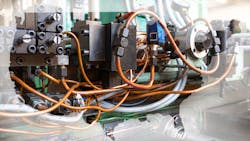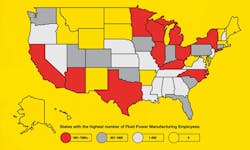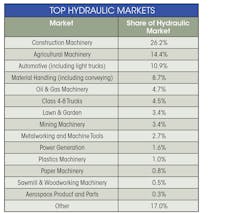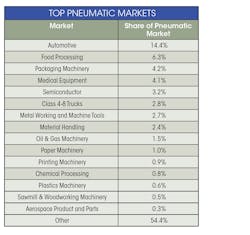Fluid power systems, which includes hydraulics and pneumatics, transmit more power in smaller spaces than other forms of power transmission, making fluid power the technology of choice for engineers and designers across dozens of industries and markets, according to the most recent (2020) U.S. Fluid Power Industry Brief from the National Fluid Power Association (NFPA).
Many industrial sectors suffered during the COVID-19 pandemic. The fluid power industry, for example saw annual shipments of pneumatics and hydraulics products drop by as much as 20^ compared to the previous year.
The fluid power industry did manage to change direction to support healthcare efforts in limiting the spread of COVID-10 and treating those who contracted it. For example, many fluid power companies adjusted production and design schedules to focus on ventilators, protective gear and other tools for doctors, nurses, and other essential healthcare workers.
Here’s a quick look at the state of the fluid power industry in the U.S.
In 2020, about 744 U.S. companies had more than 64,000 people on their payroll to make $18.2 billion of fluid power components. These companies also managed to make and export fluid power components worth $5.6 billion to 190 countries around the world. This was a 60% increase over exports in 2010, 10 years earlier.
The top 10 export destinations, accounting for 72% of all hydraulic and pneumatic exports, are Mexico, Canada, China, Germany, the United Kingdom, Brazil, Australia, Japan, Singapore, and France.
The U.S. companies making fluid power components are spread across 34 of the 50 U.S. states. Those companies spend $4.4 billion on salaries for their fluid power employees. The 10 states with the highest number of fluid power employees are Ohio, Michigan, Illinois, California, New York, Texas, Wisconsin, Arizona, Minnesota, and Kentucky.
U.S. companies that use fluid power components employ more than 845,000 people for an annual payroll exceeding $60 billion, according to the NFPA.
When the COVID pandemic calms down, the fluid power industry is looking to move forward. To that end, NFPA has devised a technology roadmap that identifies key research and development challenges for the industry that will guide it in meeting the needs of its customers. The new goals for this roadmap mirror those of many other engineering disciplines and companies. It includes helping customer clients:
- Increase availability and up-times.
- Increase productivity and performance by automating operations and using integrated data and intelligence.
- Deliver equipment and machine on-time delivery by decreasing lead times.
- Reduce capital and operating costs.
- Comply with environmental and safety regulations and machine directives.
- Simplify maintenance and make it more predictable by leveraging data and intelligence.
- Increase energy efficiency by reducing weight and increasing power densities.
About the Author
Stephen Mraz
Steve serves as Senior Editor of Machine Design. He has 23 years of service and has a B.S. Biomedical Engineering from Steve was a Flight officer in the U.S. Navy. He is currently responsible for areas such as aerospace and medical.

Leaders relevant to this article:



